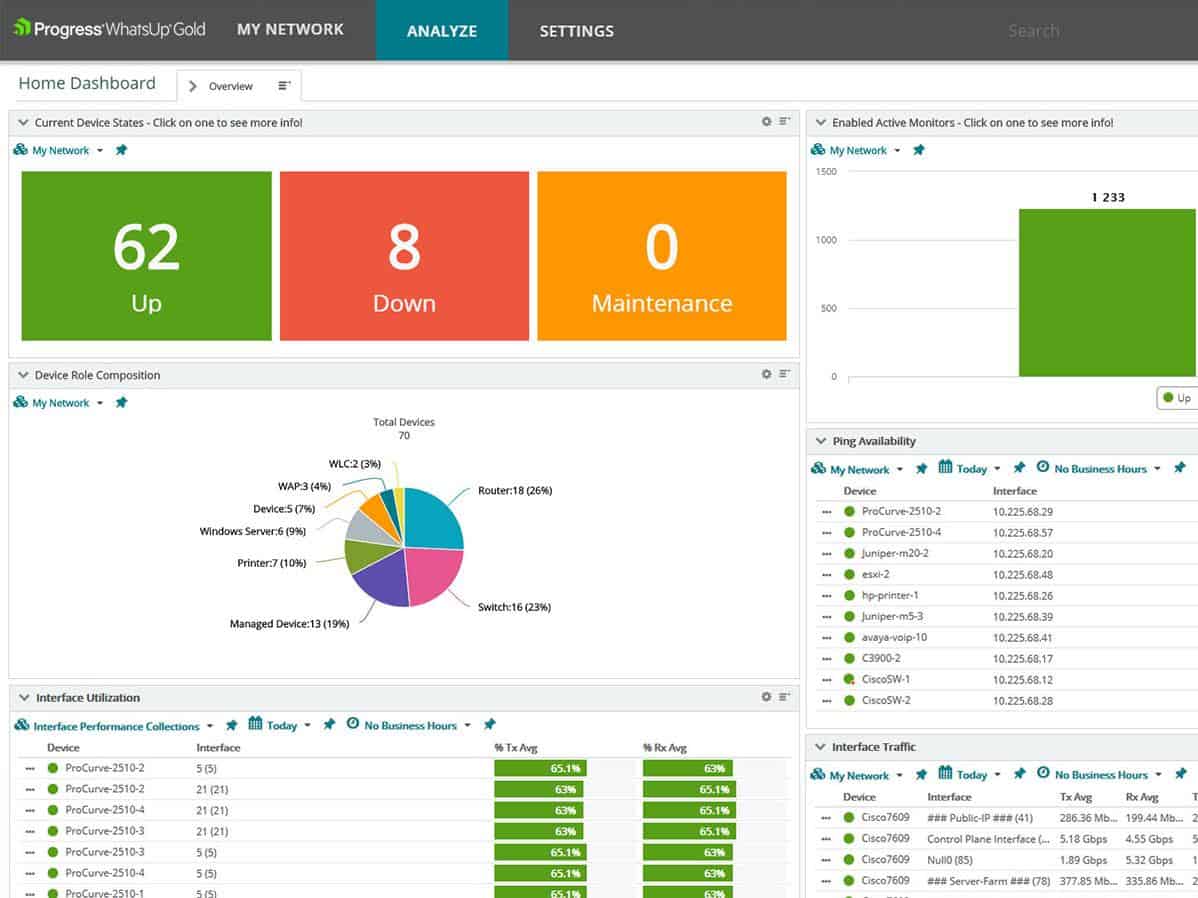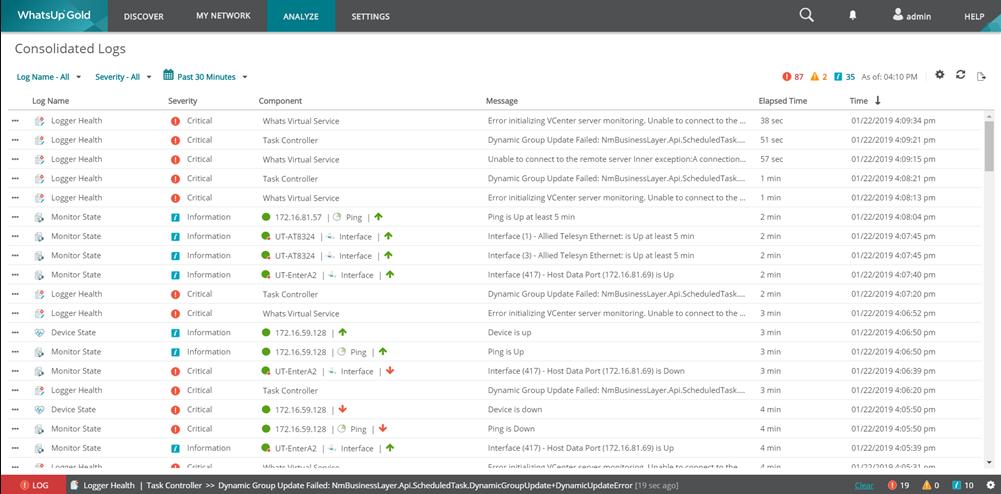Our funding comes from our readers, and we may earn a commission if you make a purchase through the links on our website.
WhatsUp Gold Review
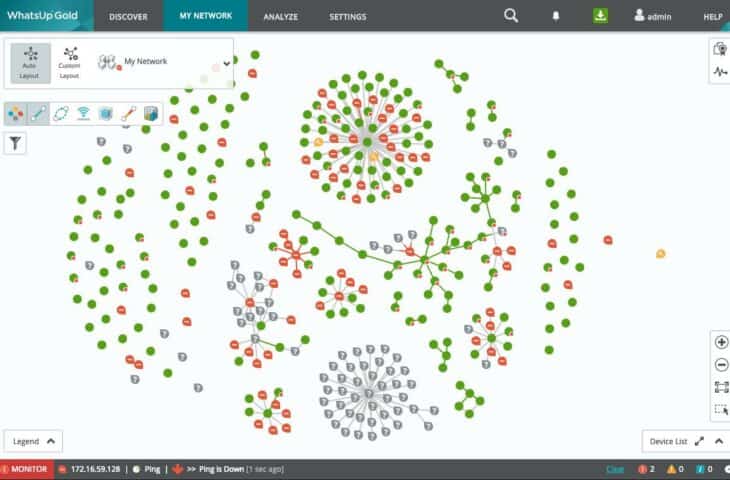
UPDATED: December 1, 2022
WhatsUp Gold is a powerful network performance monitor and it can be extended to cover all IT resources.
WhatsUp Gold is a network monitoring package that is produced By Progress Software Corporation. The software was developed by Ipswitch, Inc and that company was acquired by Progress in May 2019. Progress has re-packaged the product from its previous name of WhatsUp Gold 2017.
Progress WhatsUp Gold specializes in network performance monitoring by exploiting the services of the Simple Network Management Protocol. The software installs on Windows Server and it is becoming a major rival to monitoring industry leaders SolarWinds Network Performance Monitor, PRTG, and ManageEngine OpManager.
This service is suitable for businesses of all sizes. However, as there is no free version, small enterprises might find the package a little out of their price range. Thanks to features such as autodiscovery, network mapping, dashboard graphics, and performance alerts, the monitor is very easy to use. The package integrates network management expertise and takes care of regular network supervision, so now, you don’t need to be a highly qualified network engineer in order to manage a corporate network.
WhatsUp Gold and SNMP
The core technology behind WhatsUp Gold is the Simple Network Management Protocol (SNMP). In fact, SNMP is at the heart of all systems that are categorized as network performance monitors.
The SNMP system defines a communication standard between a Manager module and agents. Each network device has an agent pre-installed on it out of the box. All that is needed in order to get the SNMP system working on a network is an SNMP manager. WhatsUp Gold provides that function.
Under SNMP, the Manager broadcasts a request for status reports. Every device agent listens to the network for a request. In the meantime, the agent scans its device constantly and fills in a form that records All statuses and actions on that device. When a request comes in, the Agent immediately sends out that form to the address that the request came from. The form is called a Management Information Base, or MIB.
The request cycle for status requests is down to the settings of the SNMP Manager. However, device agents can send out a status report without waiting for a request if it detects a serious problem on the device. This is called an SNMP Trap.
The WhatsUp Gold system gains four benefits from the SNMP system:
- Autodiscovery
- Network topology mapping
- Live statuses
- Alerts
These are the key monitoring features of the WhatsUp Gold service.
Autodiscovery
The WhatsUp Gold software doesn’t need to know what devices are on the network in order to send out a request because that demand is broadcast on the network. The responses to the request include all identifiers of the devices that SNMP agents guard. This enables WhatsUp Gold to compile an asset inventory and start monitoring the network.
The asset inventory can be updated with every status request cycle. So, if a device is removed from the network, there won’t be a report on that piece of equipment in the next response cycle and WhatsUp Gold will know to take this out of the list of live equipment. If a device is added, it will respond to the next SNMP request after it goes live. This response will provoke a new entry to appear in the asset inventory.
Network topology mapping
Details in the MIB include which other devices each piece of equipment is connected to. WhatsUp Gold is able to draw up a network topology map from this information. As with the asset inventory, the map gets updated if different information comes in with the responses to a subsequent request. Not only can this system spot when devices are added or removed, it can also identify changes in connections between existing devices.
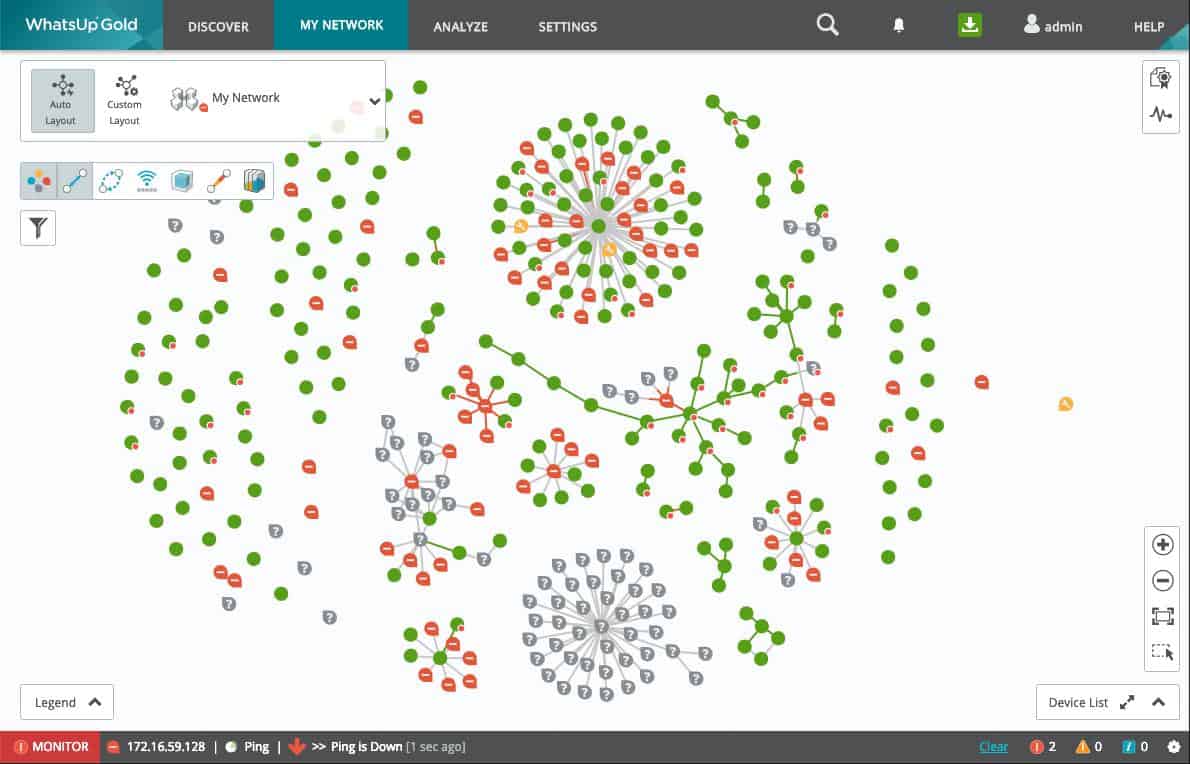
The autodiscovery and network topology mapping services are great assistants for network managers who are taking over an undocumented network. The equipment tracking features of WhatsUp Gold provide a documentation base for the entire network.
The system also includes a reporting module that can help network managers communicate the layout of the network. This is a great feature for those who are under pressure from senior management to get the network under control. An orderly list of devices and a visual representation of the network goes a long way to show that you have got the situation under control.
Live statuses
The inventory acts as an index of all devices and creates a menu in the dashboard, through which the user can get details of each device. The WhatsUp Gold console shows live graphs on a range of statistics for each device and for the overall group of each device type.
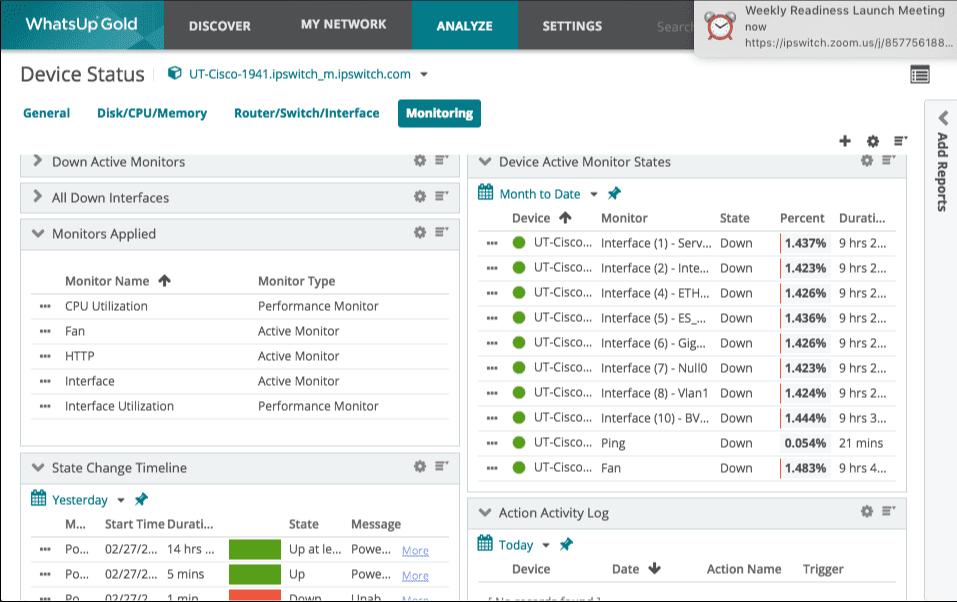
The graphs in the dashboard look great. They are color-coded so problems can be noticed instantly. However, the regular operations of the network can be supervised by WhatsUp Gold without manual intervention. So, most network managers don’t spend much time looking at the WhatsUp Gold screens.
Alerts
The main reason that most users of WhatsUp Gold don’t pay much attention to the screens of the system lies with the service’s alerting mechanism. You don’t have to sit and watch the console’s live statuses feedback in order to catch a problem. The alerting mechanism in the monitoring service will draw you back to the console if your attention is needed. This means that you can get on with other system management tasks and leave everyday supervision of the network to the automated WhatsUp Gold processes.
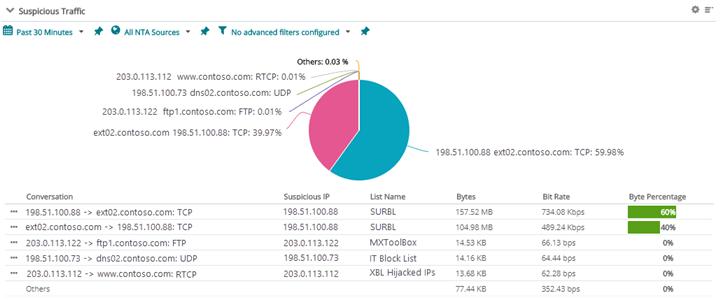
System alerts are derived from SNMP Trap messages. As Traps are only generated when a device has a problem, network managers only need to take action when a Trap message arises. Thus, WhatsUp Gold gives out alerts in response to Traps. The user is able to specify that alerts should be forwarded as notifications by email, SMS, or desktop notification. These messages can be directed to different team members according to their source or severity.
The WhatsUp Gold system also includes a system of performance thresholds. These can be set by the user and they operate on the live status data sent in by SNMP agents. An example of a threshold would be if throughput drops below a certain level. If a threshold is crossed, WhatsUp Gold will create an alert, which will also be sent out as a notification.
WhatsUp Gold add-on modules
The base service of WhatsUp Gold is its network performance monitor. This system can be expanded by add-on modules to create a complete IT resource monitoring package. These modules are:
- Network Traffic Analysis
- Application Performance Monitor
- Log management
- Configuration Management
- Virtualization Monitoring
- Failover Management
None of these modules can be bought individually without the base WhatsUp Gold network performance monitoring system. Like the base module of WhatsUp Gold, the system monitoring services among the add-ons include performance thresholds that will trigger alerts on the dashboard and notifications by email or SMS.
Network Traffic Analysis
The Network Traffic Analysis module of WhatsUp Gold differs from the base package because it focuses on traffic flows around the network rather than on the4 statuses of network devices. Although there are capacity and throughput data fields in the SNMP MIB, the Network Traffic Analysis system uses flow protocols for a data source.
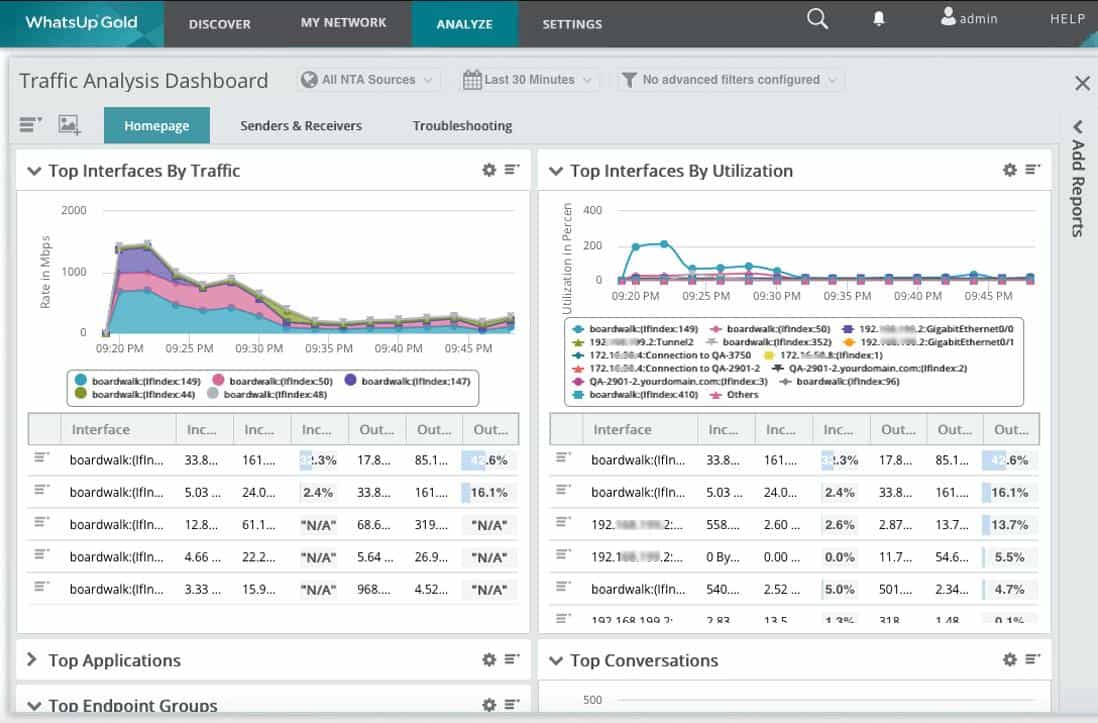
The messaging systems that this module uses to query traffic statistics from network devices are NetFlow, sFlow, J-Flow, SEL, QUIC, and IPFIX. The traffic analysis system is also able to operate a protocol analyzer, demonstrating traffic volumes per application.
The Network Traffic Analysis module provides live displays of traffic flows and also offers capacity planning tools that include measures to implement queueing and traffic prioritization. Network managers can spot applications that are not time-sensitive, moving them to run out of office hours and free up bandwidth for more immediate needs.
Application Performance Monitor
While the base module watches over network device performance, the Application Performance Monitor watches server performance as part of its main remit to track the performance of applications.
Although all of the modules of WhatsUp Gold install on Windows Server, this add-on is able to monitor Linux servers across a network. The applications that the service can monitor include Microsoft services, such as SharePoint, Active Directory, Exchange Server, and Hyper-V.
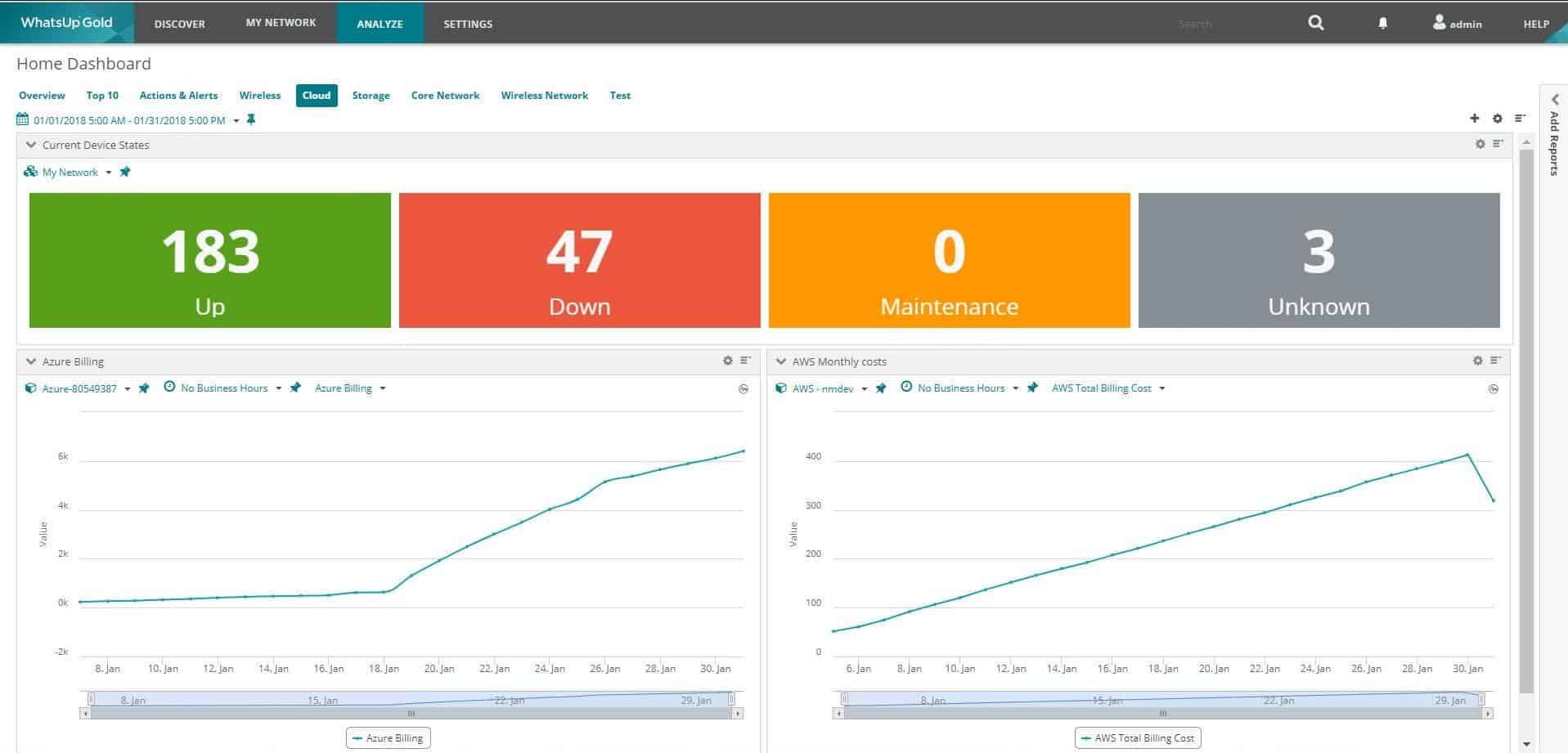
Web servers, database management systems and Web development frameworks can also be monitored with this add-on. The system can include custom-developed software in its monitoring system and it can also be integrated into other software through an API.
As well as issuing alerts when it encounters a system problem, the APM can be set to tun remediation scripts automatically to adjust or bounce the server or its processes to get the systems applications running properly again.
Log Management
The Log Management module of WhatsApp Gold collects messages from all devices connected to the network, regardless of the operating system. It consolidates log messages from Syslog and Windows Events and files them. The service utilizes the Elastic Search system for log files searching, which enables you to build your own applications to detect anomalies or even see network intrusion.
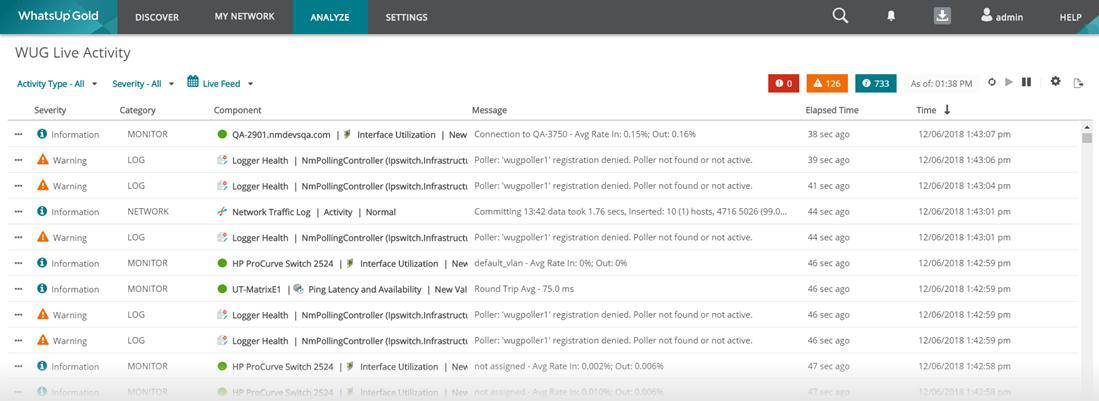
The Log Management service opens up in the WhatsUp Gold interface, offering visualizations of log message volumes and other statistics that can be segmented by source and severity. The dashboard’s utilities guide you with suggestions on how to get meaningful system insights from log file sources. It is possible to specify alert conditions and get those forwarded to team members as email and SMS notifications.
Configuration Management
The Network Configuration management add-on of WhatsUp Gold controls the settings of network devices, such as switches, routers, and firewalls. The system allows you to take a snapshot of a typical device within a group, alter its settings to create a standard profile, store an image of that configuration, and then roll it out to all other devices of the same type. With this method, you can standardize all of the network devices under your control without having to manually visit the management console of each and entering all of the same settings over and over again.
Once you have a stored library of device configuration images, onboarding new devices become very easy. You can also adjust the settings of all devices by altering just one and then rippling those changes out around the network.
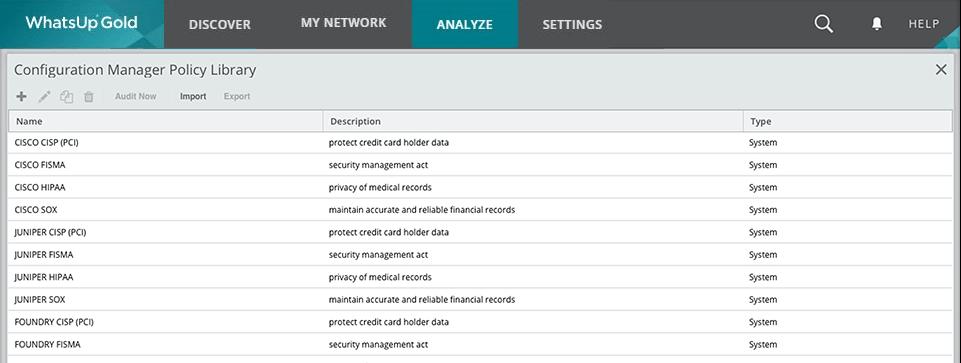
The WhatsUp Gold Configuration Management service periodically checks the settings of each of the devices that it has been tasked with managing. It checks the configuration of each against the stored image and if changes have been made since the last check, it will reset those by reapplying the stored image. This is a security service that prevents accidental or malicious changes to network device configurations.
This service is necessary for businesses that implement data security standards, such as HIPAA, PCI DSS, and SOX. Logging features in the service also contribute towards security auditing procedures.
Virtualization Monitoring
Although the Application Performance Monitoring module of WhatsUp Gold included virtualization monitoring, this technology gets deeper coverage in the Virtualization Monitoring add-on.
This module discovers all of your virtualization implementations and maps them, noting the allocation of VMs to virtual servers and also checking on the resource allocation from the physical server that supports the entire virtual infrastructure.
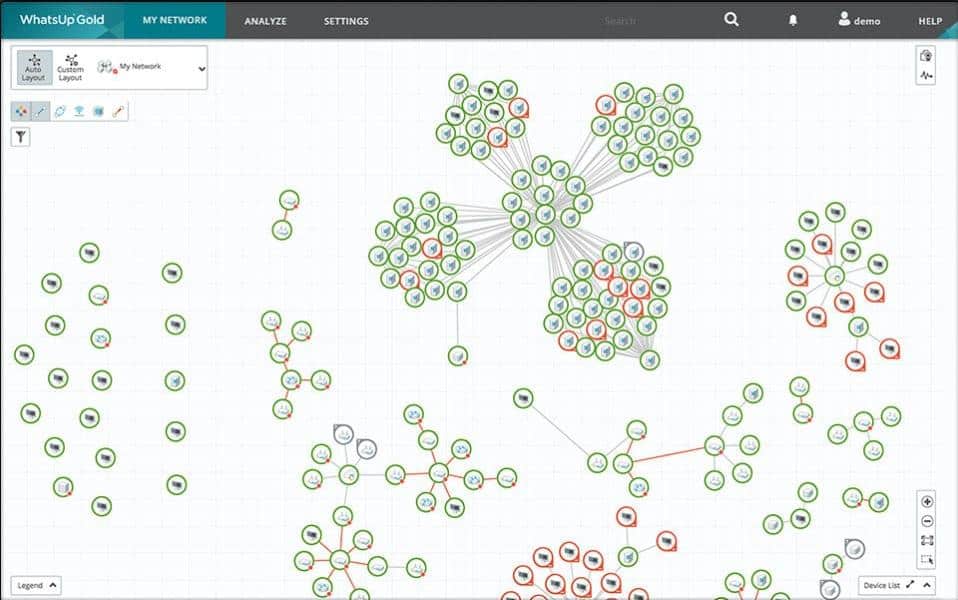
This system is able to monitor VMware and Hyper-V implementations. It will keep an eye on performance and alert you if things go wrong, so you don’t have to attend the dashboard constantly in order to assure acceptable performance on your virtualizations.
Failover Management
The Failover Manager add-on of WhatsUp Gold runs another copy of the network performance monitor plus all associated add-ons on a second server. If the primary host for the service goes down, the system on the backup server automatically takes over.
The failover service requires the backup host to have a license for the WhatsUp Gold services as well as the license acquired for the primary server.
Pros:
- Uses simple visualizations to help provide at-a-glance insights
- Supports modular pricing, allowing companies to pay only for features they intend to use
- Ideal for SMB environments
- Excellent dashboard and reporting visuals
- Can monitor LANs, WANs, and cloud-based applications such as container environments
Cons:
- Modular upgrades might not be a good fit if you intend on utilizing all aspects of a networking monitor
WhatsUp Gold editions
WhatsUp Gold is delivered as on-premises software. After committing to buy the base package, which offers network performance monitoring you can select any add-on module that suits your needs. However, it is slightly cheaper to buy those add-ons in a bundle with the main package. These bundles are marketed as editions.
The base package of WhatsUp Gold is called the Premium edition. It is available on an annual subscription or as a perpetual license for a one-time fee.
A plan that includes the base package plus all of the add-ons is called Total Plus. This is only available for a perpetual license. This includes Network Traffic Analysis, Application Monitoring, Configuration Management, Virtualization Monitoring. And Log Management add-ons. The Failover service is an add-on to both the Premium and Total Plus editions.
The Premium plan is marketed with the capability to monitor multiple sites and this is called the Distributed edition. An adaptation of the Premium plan for managed service providers is called the MSP edition.
There are also two bundles available that include some of the addons with the Premium edition. These are the Network Admin Bundle, which includes the Network Traffic Analysis and Configuration Management add-ons, and the Systems Admin Bundle, which includes the Application Monitoring and Virtualization Monitoring add-ons.
Ipswitch used to publish a price tariff for WhatsUp Gold and each of its add-ons and bundles. However, since Progress took over the company, the price list has been removed from the site. Instead, potential customers are encouraged to contact the Sales Department for a quote.
Conclusion
WhatsUp Gold is a worthy rival of the leading network performance monitoring systems. However, many potential buyers might be put off by Progress’s reluctance to publish the price of the package.
The software for WhatsUp Gold runs on Windows Server 2012 and later, so if you only have Linux servers, you won’t be very interested in this system.
For those that have the right server operating system, you can put WhatsUp Gold through its paces with a 14-day free trial and decide for yourself.

